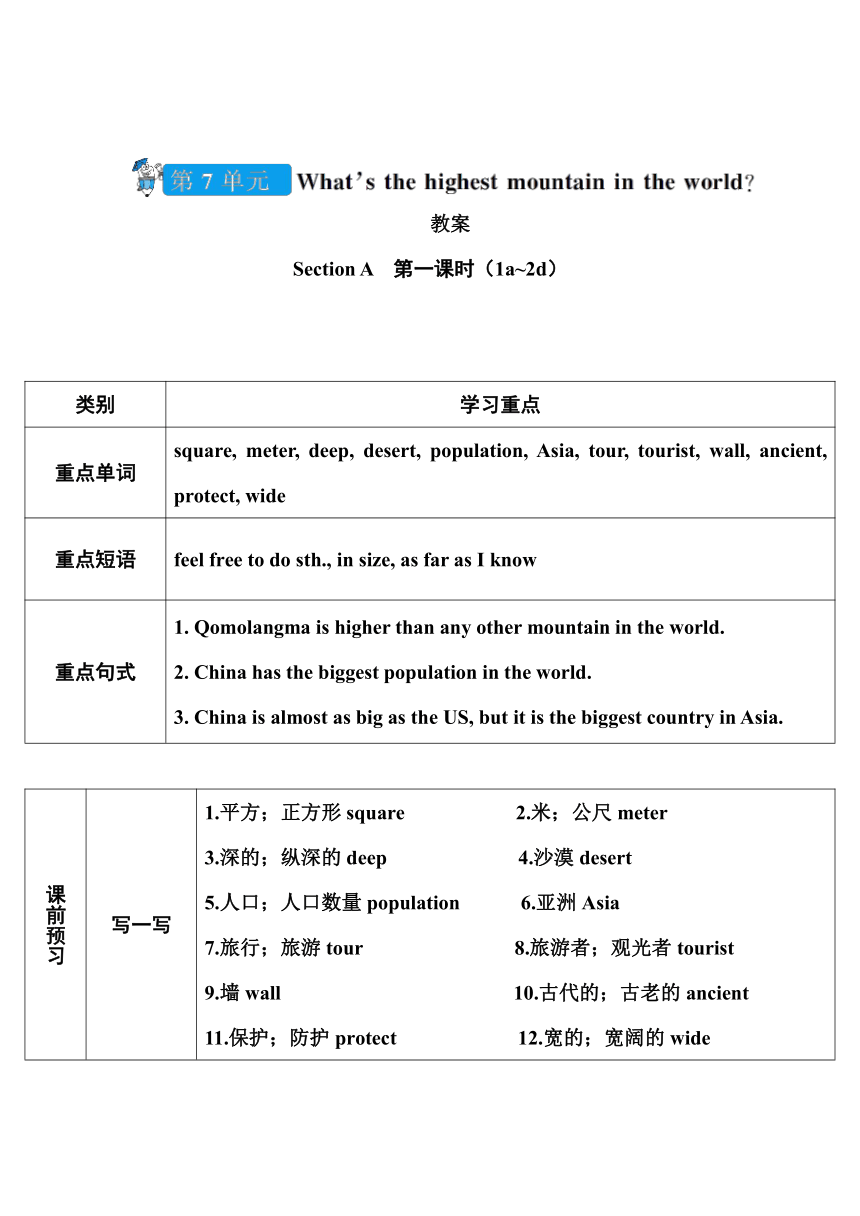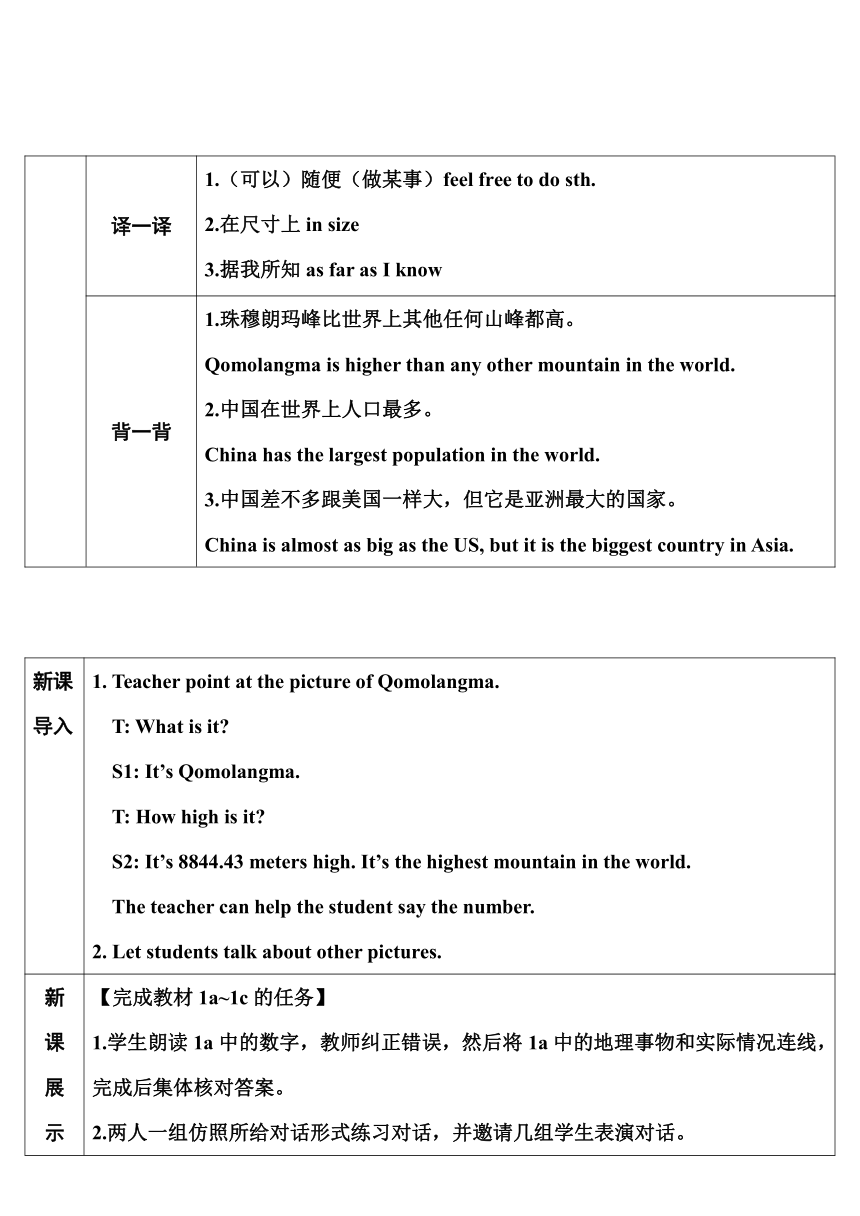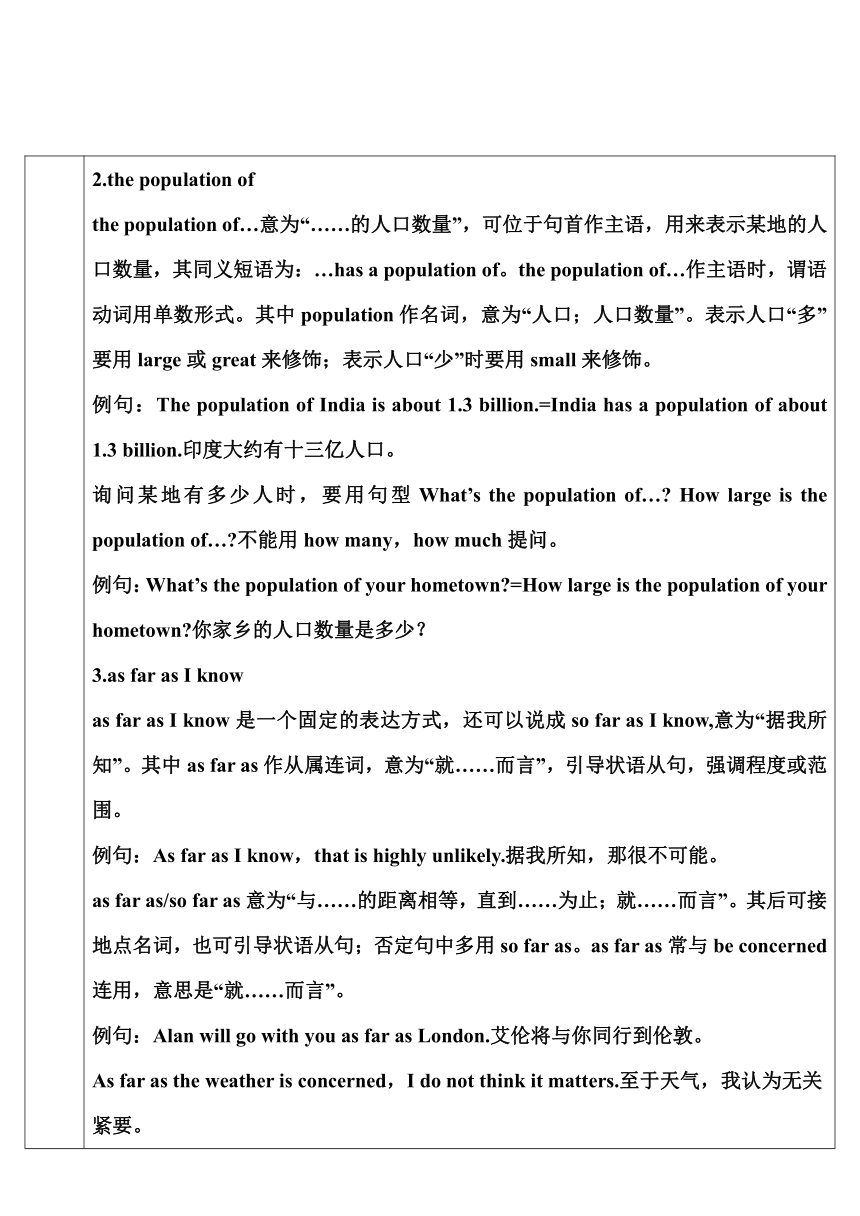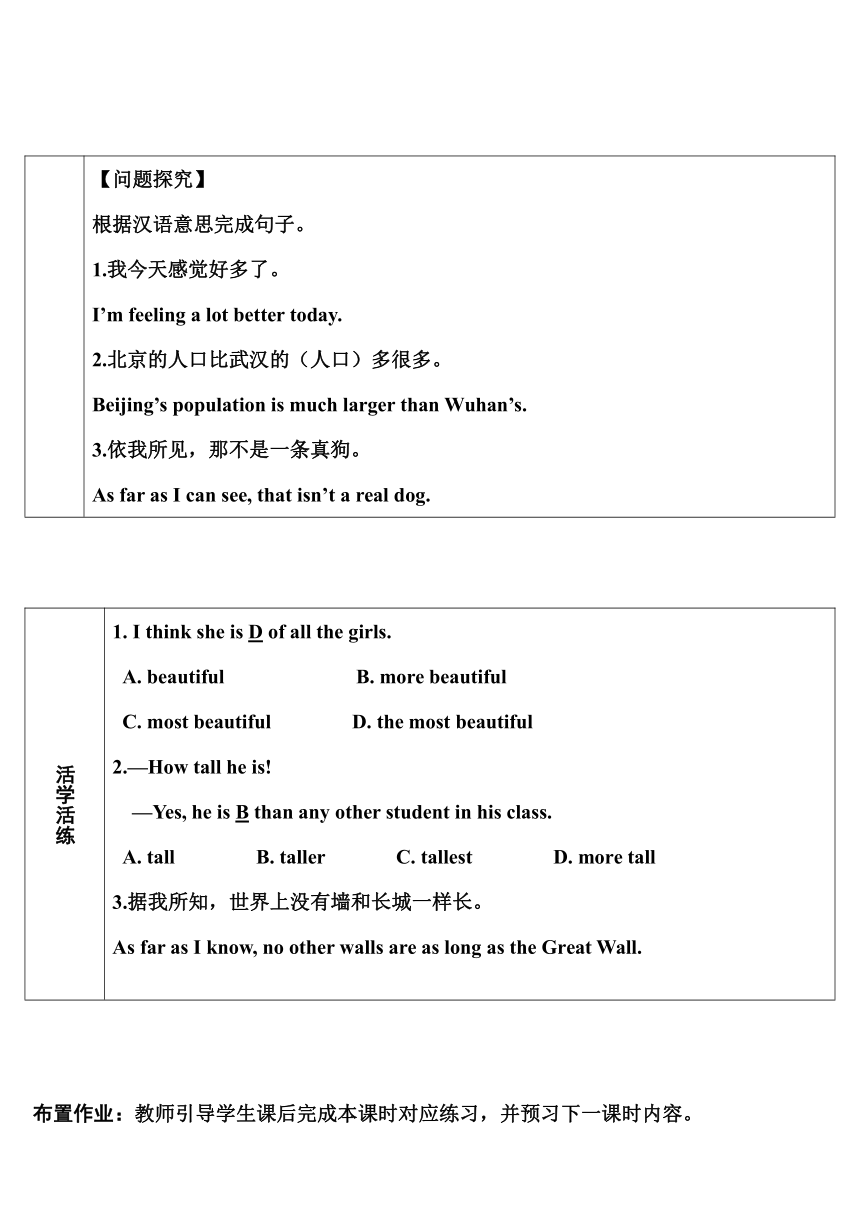人教版初中英语八下Unit 7 What's the highest mountain in the world?教案(5课时)
文档属性
| 名称 | 人教版初中英语八下Unit 7 What's the highest mountain in the world?教案(5课时) |  | |
| 格式 | doc | ||
| 文件大小 | 215.5KB | ||
| 资源类型 | 教案 | ||
| 版本资源 | 人教新目标(Go for it)版 | ||
| 科目 | 英语 | ||
| 更新时间 | 2021-05-25 10:40:55 | ||
图片预览





文档简介
教案
Section A 第一课时(1a~2d)
类别 学习重点
重点单词 square, meter, deep, desert, population, Asia, tour, tourist, wall, ancient, protect, wide
重点短语 feel free to do sth., in size, as far as I know
重点句式 1. Qomolangma is higher than any other mountain in the world.
2. China has the biggest population in the world.
3. China is almost as big as the US, but it is the biggest country in Asia.
课前预习 写一写 1.平方;正方形square 2.米;公尺meter
3.深的;纵深的deep 4.沙漠desert
5.人口;人口数量population 6.亚洲Asia
7.旅行;旅游tour 8.旅游者;观光者tourist
9.墙wall 10.古代的;古老的ancient
11.保护;防护protect 12.宽的;宽阔的wide
译一译 1.(可以)随便(做某事)feel free to do sth.
2.在尺寸上in size
3.据我所知as far as I know
背一背 1.珠穆朗玛峰比世界上其他任何山峰都高。
Qomolangma is higher than any other mountain in the world.
2.中国在世界上人口最多。
China has the largest population in the world.
3.中国差不多跟美国一样大,但它是亚洲最大的国家。
China is almost as big as the US, but it is the biggest country in Asia.
新课导入 1. Teacher point at the picture of Qomolangma.
T: What is it?
S1: It’s Qomolangma.
T: How high is it?
S2: It’s 8844.43 meters high. It’s the highest mountain in the world.
The teacher can help the student say the number.
2. Let students talk about other pictures.
新 课
展
示
新
课
展
示
【完成教材1a~1c的任务】
1.学生朗读1a中的数字,教师纠正错误,然后将1a中的地理事物和实际情况连线,完成后集体核对答案。
2.两人一组仿照所给对话形式练习对话,并邀请几组学生表演对话。
3.认真听录音,将1b中的句子补充完整,完成后集体核对答案。
4.两人一组利用1a和1b中信息仿照1c的形式编练新的对话,完成后要求几组学生表演对话。
【完成教材2a~2d的任务】
1.听录音,根据听到的顺序为句子标号,集体核对答案。
2.再认真听一遍录音,将2a中的数字填在合适的句子中,完成后集体核对答案。
3.听第三遍录音,学生跟读。
4.两人一组利用2a句子中的信息,仿照2c的形式编练新的对话,邀请几组学生表演新的对话。
5.大声朗读2d中的对话,读熟后与同伴结对练习,分角色表演对话。
6.邀请三组同学来表演对话。
【语法提要】
1.a lot
a lot意为“很;非常”,在句中用来修饰形容词的比较级bigger,表示“……得多”。在比较级结构中,为了强调形容词或副词的程度,可在其前用a lot,a little,a bit,much,even,any,still等副词(短语)修饰。
例句:Please speak a little/a bit louder.请稍微大点声说话。
(1)a lot作副词短语意为“非常”时,可用来修饰动词。
例句:She has spent a lot on clothes.她在买衣服上花费很多。
(2)a lot of=lots of意为“许多;大量”,既可修饰可数名词,相当于many,也可修饰不可数名词,相当于much。
例句:There were a lot of/lots of people in the cinema.电影院里有很多人。
2.the population of
the population of…意为“……的人口数量”,可位于句首作主语,用来表示某地的人口数量,其同义短语为:…has a population of。the population of…作主语时,谓语动词用单数形式。其中population作名词,意为“人口;人口数量”。表示人口“多”要用large或great来修饰;表示人口“少”时要用small来修饰。
例句:The population of India is about 1.3 billion.=India has a population of about 1.3 billion.印度大约有十三亿人口。
询问某地有多少人时,要用句型What’s the population of…? How large is the population of…?不能用how many,how much提问。
例句:What’s the population of your hometown?=How large is the population of your hometown?你家乡的人口数量是多少?
3.as far as I know
as far as I know是一个固定的表达方式,还可以说成so far as I know,意为“据我所知”。其中as far as作从属连词,意为“就……而言”,引导状语从句,强调程度或范围。
例句:As far as I know,that is highly unlikely.据我所知,那很不可能。
as far as/so far as意为“与……的距离相等,直到……为止;就……而言”。其后可接地点名词,也可引导状语从句;否定句中多用so far as。as far as常与be concerned连用,意思是“就……而言”。
例句:Alan will go with you as far as London.艾伦将与你同行到伦敦。
As far as the weather is concerned,I do not think it matters.至于天气,我认为无关紧要。
【问题探究】
根据汉语意思完成句子。
1.我今天感觉好多了。
I’m feeling a lot better today.
2.北京的人口比武汉的(人口)多很多。
Beijing’s population is much larger than Wuhan’s.
3.依我所见,那不是一条真狗。
As far as I can see, that isn’t a real dog.
活学活练 1. I think she is D of all the girls.
A. beautiful B. more beautiful
C. most beautiful D. the most beautiful
2.—How tall he is!
—Yes, he is B than any other student in his class.
A. tall B. taller C. tallest D. more tall
3.据我所知,世界上没有墙和长城一样长。
As far as I know, no other walls are as long as the Great Wall.
布置作业:教师引导学生课后完成本课时对应练习,并预习下一课时内容。
教学反思 本课时中数字较多,而且也较大。要求学生熟读数字,并且注意听数的读法。多听多读才能对数字敏感起来。
教学过程中老师的疑问:
教师点评和总结:
教学说明:
由珠穆朗玛峰图片过渡到学生讨论的话题,衔接自然,学生易于接受,能勾起学生的学习欲望。
教学说明:
听说结合,向学生传达语言目标,通过结对对话练习,使语言目标得以强化。
Section A 第二课时(3a~4c)
类别 学习重点
重点单词 achievement, thick, include, condition, succeed, achieve, force, nature, ocean
重点短语 take in, in the face of, even though, the Pacific Ocean
重点句式 1. It is 8,844.43 meters high and so it is very dangerous to climb.
2. We should never give up trying to achieve our dreams.
3. It’s also very hard to take in air as you get near the top.
4. It also shows that humans can sometimes be stronger than the force of nature.
课前预习 写一写 1.成就;成绩achievement 2.厚的;浓的thick
3.包括;包含include 4.条件;状况condition
5.实现目标;成功succeed 6.完成;达到;成功achieve
7.力;力量force 8.大自然;自然界nature
9.大海;海洋ocean
译一译 1.吸入;吞入(体内)take in
2.面对(问题;困难等)in the face of
3.即使;虽然even though
背一背 1.它高8844.43米,所以攀登它是很危险的。
It is 8,844.43 meters high and so is very dangerous to climb.
2.我们应该从不放弃,努力来实现我们的梦想。
We should never give up trying to achieve our dreams.
3.当你接近峰顶时连呼吸都很困难。
It’s also very hard to take in air as you get near the top.
4.这也证明了人的力量有时比自然力量强大。
It also shows that humans can sometimes be stronger than the forces of nature.
新课导入 Teacher:(Show a picture of Qomolangma)This is the highest mountain in the world, and it’s very dangerous for people to climb. But many people try to climb this mountain. Do you know who has reached the top? What can we learn from the climbers? And what does the spirit of the climbers tell us? Now let’s read the passage on Page 51.
新 课
展
示
新
课
展
示
【完成教材3a~3c的任务】
1.快速阅读短文,将方框中的三个段落和段意匹配,完成后让学生展示答案,教师点拨。
2.认真阅读短文,根据短文内容完成3b中的表格,请几名学生展示答案,完成后教师点拨。
3.再次认真阅读短文,用3a中的短语来完成3c中的句子填空,完成后请学生展示答案,教师点拨。
4.熟读短文,识记并背诵知识要点。
【完成教材Grammar Focus~4c的任务】
1.学生朗读Grammar Focus中的句子。
2.参考学案上的单元同步语法讲练,引导学生归纳语法知识。
3.阅读4a中的生词并完成4a的练习。
4.阅读4b中的句子,然后仿照4b的形式根据所给出的提示来写出两组比较的句子,小组交流答案。
5.写出5个含有比较级及最高级的句子。
【语法提要】
1.take in
take in为固定短语,意为“吸入;吞入(体内)”。
例句:Open the window and take in fresh air.打开窗户,吸入新鲜空气。
Don\'t let children take in small parts of toys.千万不要让孩子将玩具的零部件吞入体内。
take in的其他含义:
(1)收留;留宿
例句:He had no places to sleep in so we offered to take him in.他没有地方可睡,于是我们提出让他留宿。
(2)充分理解;掌握
例句:It took me a long time to take in what you were saying.我费了好长时间才明白你说的话。
2.force
force名词,意为“力;力量”。常见短语:the forces of nature自然力量,the force of an explosion爆炸力。
例句:The force of the explosion destroyed many tall buildings.那次爆炸的力量摧毁了许多高大的建筑物。
force还可用作动词,意为“强迫;迫使”。force sb.to do sth.意为“迫使某人做某事”。
例句:They forced him to leave the small town.他们强迫他离开小镇。
【问题探究】
1. On weekends the Smiths usually drives to the countryside and A the fresh air.
A. take in B. take out C. bring in D. bring out
2.自然的力量是巨大的。 The force of nature is enormous.
活学 活练 The club A a new member last week.
A. took in B. took part in C. took in hand
布置作业:教师引导学生课后完成本课时对应练习,并预习下一课时内容。
教学反思 本课时通过提问引入新课的方式激发学生的学习兴趣,并在讲练结合的基础上帮助学生掌握比较级和最高级,从而达到了较好的教学效果。
教学过程中老师的疑问:
教师点评和总结:
教学说明:
通过阅读分析文章,学生的阅读分析能力在这一环节得到了提升。
Section B第3课时 (1a~1d)
类别 学习重点
重点单词 weigh, birth, adult
重点短语 at birth, up to
重点句式 1. The elephant is 350cm tall and weighs 5,000 kilos.
2. This elephant weighs many times more than this panda.
课前预习 写一写 1.重量是……;称……的重量weigh
2.出生;诞生birth
3.成年的;成人的;成人;成年动物adult
译一译 1.出生时at birth
2.到达;至多有;不多于up to
背一背 1.大象高3.5米,重达5000 千克。
The elephant is 350 cm high and weighs 5000 kilos.
2.成年熊猫要比熊猫幼仔重许多倍。
An adult panda weighs many times more than a baby panda.
新课导入 (Teacher show two pictures to the students. One is a picture of a panda and the other is an elephant.)
T: What’s this?
S1: It’s a panda.
T: What’s this?
S2: It’s an elephant.
T: Can you say something about the two animals with Comparative Forms of Adjectives and Adverbs? Let’s have a try.
新 课
展
示
新
课
展
示
【完成教材1a~1d的任务】
1.认真阅读1a中所给的信息,然后用这些信息仿照给出的例句对大象和熊猫进行比较,邀请几位学生说出自己所想的句子。
2.请学生朗读出1b方框中的数字,教师纠正读音,为听力做好准备。
3.听录音,标出你所听到的数字,集体核对答案,完成1c练习。
4.再听一遍录音,用正确的数字来补全句子,请学生展示答案。
5.再细心听录音并跟读,整体感知对话。
6.游戏接龙:根据听力信息或自己熟知的有关熊猫的内容,小组内轮流说出有关熊猫的句子,比一比谁说得多说得好,邀请几组学生来展示。
【语法提要】
1.many times more than
many times more than意为“比……多很多倍”,是倍数的表达方式之一。英语中常用的倍数表达法:
(1)“A+谓语动词+ 倍数+形容词/副词的比较级+ than +B”表示“A比B……多少倍”。
例句:He runs three times faster than his brother.他跑得比他弟弟快三倍。新
(2)“A+谓语动词+倍数+as+形容词/副词的原级+as+B”表示“A是B的多少倍……”。
例句:His father is twice as tall as he.他父亲的身高是他的两倍。
This tree is three times as tall as that one.这棵树是那棵树的三倍高。
(3)“A+谓语动词+倍数+the height/weight/length … +of+B” 表示“A的高度/重量/长度……是B的多少倍”。
例句:This hill is four times the height of that small one.这座山的高度是那座小山的四倍。
2.up to
up to意为“到达(某数量、程度等);至多有;不多于”,其中to为介词,后接名词作宾语。
例句:Up to ten people can sleep in this tent.这个帐篷最多能睡十人。
Our football team played up to its best in the last match.我们的足球队在上次比赛中发挥了最高水平。
up to还可表示“(体力或智力上)能胜任;适于(做某事)”,后可接名词或动词作宾语。常用于否定句。
例句:He’s not up to the monitor.他无法胜任班长。
He’s not really up to seeing any visitors.他的身体不太适合见访客。
【问题探究】
根据汉语意思完成句子。
1.他们的房间比我们的大两倍。
Their room is twice bigger than ours.
2.在非洲的一些地区,孩子最多受教育到12岁。
In some areas of Africa, children get educated up to 12 years old.
活学活练 1. Jim is funnier than A in his class.
A. any other boy B. any boy
C. any other boys D. all the boys
2.—Why don’t you buy this book?
—Because it is B of the two books.
A. expensive B. more expensive
C. most expensive D. the most expensive
布置作业:教师引导学生课后完成本课时对应练习,并预习下一课时内容。
教学反思 本课时通过展示两种动物的图片,由提问引入,加强了师生互动,从而引导学生针对展示的动物发表各自的见解,听、说、练结合,再加上教师适当的点拨和指导,强化了学生对比较级和数字类知识的掌握和运用。
教学过程中老师的疑问:
教师点评和总结:
教学说明:
由图片引入,用比较级对两者进行比较,引出1a的教学内容,过渡自然,易于理解及引起学生的学习兴趣。
Section B第4课时(2a~2e)
类别 学习重点
重点单词 bamboo, research, keeper, awake, excitement, illness, wild, government
重点短语 die from, cut down, walk into, fall over, or so, run over, take care of
重点句式 1. They find that most of the babies are already awake and hungry.
2. The babies often die from illnesses and do not live very long.
3. Scientists say there are now fewer than 2,000 pandas living in the forests.
课前预习 写一写 1.竹子bamboo 2.研究;调查research
3.饲养员;保管人keeper 4.醒着awake
5.激动;兴奋excitement 6.疾病;病illness
7.野生的wild 8.政府;内阁government
译一译 1.因……而死亡,死于die from 2.砍伐cut down
3.走路时撞着walk into 4.绊倒fall over
5.大约or so 6.跑上前去run over
7.照顾take care of
背一背 1.他们发现绝大多数熊猫宝宝都已经醒了,也饿了。
They find that most of the babies are already awake and hungry.
2.熊猫宝宝常常死于疾病,而且不会活很久。
The babies often die from illnesses and do not live very long.
3.科学家们说现在生活在森林里的熊猫不到2000只。
Scientists say there are now fewer than 2,000 pandas living in the forests.
新课导入 (Teacher show some pictures of pandas to the students)
Teacher: Do you know what they are? Yes, they are pandas. They are very lovely. Many people like them very much. Do you like them? There are only less than two thousand pandas in China. We should play a part in saving the animals. Do you want to know what the difficulties are? And how do people protect the animals? If you want to know the answers, let’s read the article on Page 54.
新 课
展
示
新
课
展
示
【完成教材2a~2b的任务】
1.利用方框中的单词两人一组互相谈论熊猫的情况,完成后请几位学生来展示谈论的成果。
2.通读2b中的短文,找出10,1200和2000所代表的含义,请几位学生展示答案,教师点拨。
3.再次细心阅读短文,理解每一句话的意思,小组解决遇到的疑难问题。
4.教师点拨短文中出现的重点和难点。
5.熟读短文,识记并背诵知识要点。
【完成教材2c~2e的教学任务】
1.请几个同学回答2c中的问题。2.学生阅读2b中的短文,检查2c中的问题的答案。
3.认真阅读课文,用短文中的单词或短语来补全句子,并大声朗读句子。
4.熊猫是我国的国宝,我们每一个人都应该去保护它们。把你的想法和建议写出来,然后小组内交流讨论。
【语法提要】
1.run over
此句中run over,walk into和fall over均为动词短语。
(1)run over意为“跑上前去;跑过去”,其中over用作副词,意为“从……的一边到另一边;穿越”。
例句:She ran over to say hello,but I didn’t recognize her.她跑过来打招呼,但我没有认出她来。
(2)walk into意为“(走路时意外地)撞上”。
例句:As he was thinking too deeply and not paying attention to where he was going,he walked straight into a tree.由于他陷入沉思,没有注意看路,所以径直撞到了一棵树上。
(3)fall over表示“摔倒;跌跤;倒下”。
例句:Don’t run too fast,or you might fall over.别跑太快,要不你会摔跤的。
Many trees fell over after the storm.暴风雨后许多树木都倒了。
fall over sth.则表示“被某物绊倒”。
例句:Tina fell over the dog and broke her arm.蒂娜被那只狗绊了一跤,摔断了胳膊。
2.fewer
fewer是few的比较级,意为“较少的;更少的”,后接可数名词的复数形式。注意要将其与less的用法区分开来,less也表示“较少的;更少的”,但它是little的比较级,其后接不可数名词。
例句:Few people have read the book,and even fewer understand it.很少有人看过这本书,看懂的人就更少了。
3.die from
die from是动词词组,意为“死于……,因……而死。”。
例句:In big cities during cold winter months,many old people die from the polluted air.在寒冷的冬季,许多住在大城市的老年人死于空气污染。
Many villagers die every year from snake bites.每年都有许多村民被蛇咬而死亡。
die from与die of
①相同点:二者都可表示“死于……”,其宾语为表示死亡的原因。当表示因疾病死亡时,二者可互换使用。
例句:His grandfather died from/of cancer in 1999.他的爷爷于1999年死于癌症。
②具体区别如下:
die from意为“死于……,因……而死”,其宾语表示死亡的原因。具体使用时常用于由于外部创伤或间接的原因致死,如由于衰弱、饮食过度、劳累或不明原因致死。die from an earthquake (a traffic accident,a lightning,etc.)死于地震(交通事故、雷击等)。
例句:She died from a traffic accident.她死于一场交通事故。die of意为“死于……,因……而死”,其宾语表示死亡的原因。具体使用时一般用于疾病、疲劳、寒冷、饥渴、年老、失望、悲伤等人体自身原因造成的死亡。die of illness (fear,disappointment,old age,etc.)死于疾病(恐惧、失望、年老等)。
例句:He died of sorrow.他死于忧伤。
【问题探究】
根据汉语意思完成句子。
1.你越仔细,就会越少犯错。
More (much) careful you are, fewer (few) mistakes you will make.
2.昨天他下楼梯时摔到了。
He fell over while coming down the stairs yesterday.
3.我的爷爷死于心脏病。
My grandfather died from/of heart attack.
活学活练 练根据汉语意思完成句子。
1.迈克走路时不看路,撞到了墙上。
Mike wasn’t looking and walked into the wall.
2.虽然他有更多的钱,但是他朋友更少了,陪家人的时间更少了。
Although he has more money,he has fewer friends and less time with his family.
3.他上周去世了,死于疾病。
He passed away last week, died of illness.
布置作业:教师引导学生课后完成本课时对应练习,并预习下一课时内容。
教学反思 本课时以学生熟悉的动物开始,让学生有话可说。由此引入短文学习,也激发了学生的学习兴趣,在加深学生对这种动物的了解的基础上也强化了对知识点的巩固。
教学过程中老师的疑问:
教师点评和总结:
教学说明:
以熊猫数量减少以及饲养过程中出现的难题为导入点,抓住学生想探寻原因的心理,引起学生的好奇心,激发他们的学习欲望。
教学说明:
将听、说、读、写的任务结合起来可锻炼学生的语言综合运用能力和口头表达能力。
教学说明:
通过2d环节让学生对文章有了更深刻的理解;2e环节使学生知道了要爱护环境、爱护动物。
Section B第5课时(3a~3b)
类别 学习重点
重点单词 oil, huge, protection
重点短语 put…into, learn more about
重点句式 Humans catch whales for meat, fat and oil.
课前预习 写一写 1.油;食用油;石油oil 2.巨大的;极多的huge
3.保护;保卫protection
译一译 1.把……放进put…into 2.更加了解learn more about
背一背 人们捕杀鲸是为了它的肉、脂肪和油。
Humans catch whales for meat, fat and oil.
新课导入 Teacher:Do you know whales? What do they look like? Where do they live? What do they eat? Talk about whales and discuss why they need to be protected.
新 课
展
示
新
课
展
示
【完成3a~3b的任务】
1.朗读3a中关于鲸的单词和短语,并完成表格。
2.校对答案。根据3a中有关描述鲸鱼的单词和句子以及3b中所给出的句型提示来写一篇关于鲸鱼的文章,并且写出它们为什么需要得到保护,以及人们应该怎样做。
3.完成写作后小组内互相交流纠错,借鉴好词好句,教师作思路点拨。
典例参考
Whales are sea animals. They are very huge. They eat small fish and other sea animals. They are very interesting. They can jump out of the water. They can also sing and dance very well. But now some kinds of whales are in danger because there is more and more water pollution and people catch whales for meat,fat and oil. We should play a part in saving the whales because whale parts can be sold to make things like candles and soap. We should protect whales from disappearing. I think people should learn more about whales and the rules on whale protection. And I think people should stop putting rubbish into the sea.
4.教师引导学生参考学案上的单元同步作文指导,然后完成实战演练。
活学 活练 Humans catch whales A meat, fat and oil.
A. for B.to C. about D. at
布置作业:教师引导学生课后完成本课时对应练习,并预习下一课时内容。
教学反思 本课时通过了解鲸鱼的相关知识,训练了学生的口头表达能力和写作能力。同时也提高了学生们保护动物的意识。
教学过程中老师的疑问:
教师点评和总结:
教学说明:
通过写关于鲸鱼的文章,加深了对鲸鱼的认识,提高了学生的阅读能力和书面表达能力。
Section A 第一课时(1a~2d)
类别 学习重点
重点单词 square, meter, deep, desert, population, Asia, tour, tourist, wall, ancient, protect, wide
重点短语 feel free to do sth., in size, as far as I know
重点句式 1. Qomolangma is higher than any other mountain in the world.
2. China has the biggest population in the world.
3. China is almost as big as the US, but it is the biggest country in Asia.
课前预习 写一写 1.平方;正方形square 2.米;公尺meter
3.深的;纵深的deep 4.沙漠desert
5.人口;人口数量population 6.亚洲Asia
7.旅行;旅游tour 8.旅游者;观光者tourist
9.墙wall 10.古代的;古老的ancient
11.保护;防护protect 12.宽的;宽阔的wide
译一译 1.(可以)随便(做某事)feel free to do sth.
2.在尺寸上in size
3.据我所知as far as I know
背一背 1.珠穆朗玛峰比世界上其他任何山峰都高。
Qomolangma is higher than any other mountain in the world.
2.中国在世界上人口最多。
China has the largest population in the world.
3.中国差不多跟美国一样大,但它是亚洲最大的国家。
China is almost as big as the US, but it is the biggest country in Asia.
新课导入 1. Teacher point at the picture of Qomolangma.
T: What is it?
S1: It’s Qomolangma.
T: How high is it?
S2: It’s 8844.43 meters high. It’s the highest mountain in the world.
The teacher can help the student say the number.
2. Let students talk about other pictures.
新 课
展
示
新
课
展
示
【完成教材1a~1c的任务】
1.学生朗读1a中的数字,教师纠正错误,然后将1a中的地理事物和实际情况连线,完成后集体核对答案。
2.两人一组仿照所给对话形式练习对话,并邀请几组学生表演对话。
3.认真听录音,将1b中的句子补充完整,完成后集体核对答案。
4.两人一组利用1a和1b中信息仿照1c的形式编练新的对话,完成后要求几组学生表演对话。
【完成教材2a~2d的任务】
1.听录音,根据听到的顺序为句子标号,集体核对答案。
2.再认真听一遍录音,将2a中的数字填在合适的句子中,完成后集体核对答案。
3.听第三遍录音,学生跟读。
4.两人一组利用2a句子中的信息,仿照2c的形式编练新的对话,邀请几组学生表演新的对话。
5.大声朗读2d中的对话,读熟后与同伴结对练习,分角色表演对话。
6.邀请三组同学来表演对话。
【语法提要】
1.a lot
a lot意为“很;非常”,在句中用来修饰形容词的比较级bigger,表示“……得多”。在比较级结构中,为了强调形容词或副词的程度,可在其前用a lot,a little,a bit,much,even,any,still等副词(短语)修饰。
例句:Please speak a little/a bit louder.请稍微大点声说话。
(1)a lot作副词短语意为“非常”时,可用来修饰动词。
例句:She has spent a lot on clothes.她在买衣服上花费很多。
(2)a lot of=lots of意为“许多;大量”,既可修饰可数名词,相当于many,也可修饰不可数名词,相当于much。
例句:There were a lot of/lots of people in the cinema.电影院里有很多人。
2.the population of
the population of…意为“……的人口数量”,可位于句首作主语,用来表示某地的人口数量,其同义短语为:…has a population of。the population of…作主语时,谓语动词用单数形式。其中population作名词,意为“人口;人口数量”。表示人口“多”要用large或great来修饰;表示人口“少”时要用small来修饰。
例句:The population of India is about 1.3 billion.=India has a population of about 1.3 billion.印度大约有十三亿人口。
询问某地有多少人时,要用句型What’s the population of…? How large is the population of…?不能用how many,how much提问。
例句:What’s the population of your hometown?=How large is the population of your hometown?你家乡的人口数量是多少?
3.as far as I know
as far as I know是一个固定的表达方式,还可以说成so far as I know,意为“据我所知”。其中as far as作从属连词,意为“就……而言”,引导状语从句,强调程度或范围。
例句:As far as I know,that is highly unlikely.据我所知,那很不可能。
as far as/so far as意为“与……的距离相等,直到……为止;就……而言”。其后可接地点名词,也可引导状语从句;否定句中多用so far as。as far as常与be concerned连用,意思是“就……而言”。
例句:Alan will go with you as far as London.艾伦将与你同行到伦敦。
As far as the weather is concerned,I do not think it matters.至于天气,我认为无关紧要。
【问题探究】
根据汉语意思完成句子。
1.我今天感觉好多了。
I’m feeling a lot better today.
2.北京的人口比武汉的(人口)多很多。
Beijing’s population is much larger than Wuhan’s.
3.依我所见,那不是一条真狗。
As far as I can see, that isn’t a real dog.
活学活练 1. I think she is D of all the girls.
A. beautiful B. more beautiful
C. most beautiful D. the most beautiful
2.—How tall he is!
—Yes, he is B than any other student in his class.
A. tall B. taller C. tallest D. more tall
3.据我所知,世界上没有墙和长城一样长。
As far as I know, no other walls are as long as the Great Wall.
布置作业:教师引导学生课后完成本课时对应练习,并预习下一课时内容。
教学反思 本课时中数字较多,而且也较大。要求学生熟读数字,并且注意听数的读法。多听多读才能对数字敏感起来。
教学过程中老师的疑问:
教师点评和总结:
教学说明:
由珠穆朗玛峰图片过渡到学生讨论的话题,衔接自然,学生易于接受,能勾起学生的学习欲望。
教学说明:
听说结合,向学生传达语言目标,通过结对对话练习,使语言目标得以强化。
Section A 第二课时(3a~4c)
类别 学习重点
重点单词 achievement, thick, include, condition, succeed, achieve, force, nature, ocean
重点短语 take in, in the face of, even though, the Pacific Ocean
重点句式 1. It is 8,844.43 meters high and so it is very dangerous to climb.
2. We should never give up trying to achieve our dreams.
3. It’s also very hard to take in air as you get near the top.
4. It also shows that humans can sometimes be stronger than the force of nature.
课前预习 写一写 1.成就;成绩achievement 2.厚的;浓的thick
3.包括;包含include 4.条件;状况condition
5.实现目标;成功succeed 6.完成;达到;成功achieve
7.力;力量force 8.大自然;自然界nature
9.大海;海洋ocean
译一译 1.吸入;吞入(体内)take in
2.面对(问题;困难等)in the face of
3.即使;虽然even though
背一背 1.它高8844.43米,所以攀登它是很危险的。
It is 8,844.43 meters high and so is very dangerous to climb.
2.我们应该从不放弃,努力来实现我们的梦想。
We should never give up trying to achieve our dreams.
3.当你接近峰顶时连呼吸都很困难。
It’s also very hard to take in air as you get near the top.
4.这也证明了人的力量有时比自然力量强大。
It also shows that humans can sometimes be stronger than the forces of nature.
新课导入 Teacher:(Show a picture of Qomolangma)This is the highest mountain in the world, and it’s very dangerous for people to climb. But many people try to climb this mountain. Do you know who has reached the top? What can we learn from the climbers? And what does the spirit of the climbers tell us? Now let’s read the passage on Page 51.
新 课
展
示
新
课
展
示
【完成教材3a~3c的任务】
1.快速阅读短文,将方框中的三个段落和段意匹配,完成后让学生展示答案,教师点拨。
2.认真阅读短文,根据短文内容完成3b中的表格,请几名学生展示答案,完成后教师点拨。
3.再次认真阅读短文,用3a中的短语来完成3c中的句子填空,完成后请学生展示答案,教师点拨。
4.熟读短文,识记并背诵知识要点。
【完成教材Grammar Focus~4c的任务】
1.学生朗读Grammar Focus中的句子。
2.参考学案上的单元同步语法讲练,引导学生归纳语法知识。
3.阅读4a中的生词并完成4a的练习。
4.阅读4b中的句子,然后仿照4b的形式根据所给出的提示来写出两组比较的句子,小组交流答案。
5.写出5个含有比较级及最高级的句子。
【语法提要】
1.take in
take in为固定短语,意为“吸入;吞入(体内)”。
例句:Open the window and take in fresh air.打开窗户,吸入新鲜空气。
Don\'t let children take in small parts of toys.千万不要让孩子将玩具的零部件吞入体内。
take in的其他含义:
(1)收留;留宿
例句:He had no places to sleep in so we offered to take him in.他没有地方可睡,于是我们提出让他留宿。
(2)充分理解;掌握
例句:It took me a long time to take in what you were saying.我费了好长时间才明白你说的话。
2.force
force名词,意为“力;力量”。常见短语:the forces of nature自然力量,the force of an explosion爆炸力。
例句:The force of the explosion destroyed many tall buildings.那次爆炸的力量摧毁了许多高大的建筑物。
force还可用作动词,意为“强迫;迫使”。force sb.to do sth.意为“迫使某人做某事”。
例句:They forced him to leave the small town.他们强迫他离开小镇。
【问题探究】
1. On weekends the Smiths usually drives to the countryside and A the fresh air.
A. take in B. take out C. bring in D. bring out
2.自然的力量是巨大的。 The force of nature is enormous.
活学 活练 The club A a new member last week.
A. took in B. took part in C. took in hand
布置作业:教师引导学生课后完成本课时对应练习,并预习下一课时内容。
教学反思 本课时通过提问引入新课的方式激发学生的学习兴趣,并在讲练结合的基础上帮助学生掌握比较级和最高级,从而达到了较好的教学效果。
教学过程中老师的疑问:
教师点评和总结:
教学说明:
通过阅读分析文章,学生的阅读分析能力在这一环节得到了提升。
Section B第3课时 (1a~1d)
类别 学习重点
重点单词 weigh, birth, adult
重点短语 at birth, up to
重点句式 1. The elephant is 350cm tall and weighs 5,000 kilos.
2. This elephant weighs many times more than this panda.
课前预习 写一写 1.重量是……;称……的重量weigh
2.出生;诞生birth
3.成年的;成人的;成人;成年动物adult
译一译 1.出生时at birth
2.到达;至多有;不多于up to
背一背 1.大象高3.5米,重达5000 千克。
The elephant is 350 cm high and weighs 5000 kilos.
2.成年熊猫要比熊猫幼仔重许多倍。
An adult panda weighs many times more than a baby panda.
新课导入 (Teacher show two pictures to the students. One is a picture of a panda and the other is an elephant.)
T: What’s this?
S1: It’s a panda.
T: What’s this?
S2: It’s an elephant.
T: Can you say something about the two animals with Comparative Forms of Adjectives and Adverbs? Let’s have a try.
新 课
展
示
新
课
展
示
【完成教材1a~1d的任务】
1.认真阅读1a中所给的信息,然后用这些信息仿照给出的例句对大象和熊猫进行比较,邀请几位学生说出自己所想的句子。
2.请学生朗读出1b方框中的数字,教师纠正读音,为听力做好准备。
3.听录音,标出你所听到的数字,集体核对答案,完成1c练习。
4.再听一遍录音,用正确的数字来补全句子,请学生展示答案。
5.再细心听录音并跟读,整体感知对话。
6.游戏接龙:根据听力信息或自己熟知的有关熊猫的内容,小组内轮流说出有关熊猫的句子,比一比谁说得多说得好,邀请几组学生来展示。
【语法提要】
1.many times more than
many times more than意为“比……多很多倍”,是倍数的表达方式之一。英语中常用的倍数表达法:
(1)“A+谓语动词+ 倍数+形容词/副词的比较级+ than +B”表示“A比B……多少倍”。
例句:He runs three times faster than his brother.他跑得比他弟弟快三倍。新
(2)“A+谓语动词+倍数+as+形容词/副词的原级+as+B”表示“A是B的多少倍……”。
例句:His father is twice as tall as he.他父亲的身高是他的两倍。
This tree is three times as tall as that one.这棵树是那棵树的三倍高。
(3)“A+谓语动词+倍数+the height/weight/length … +of+B” 表示“A的高度/重量/长度……是B的多少倍”。
例句:This hill is four times the height of that small one.这座山的高度是那座小山的四倍。
2.up to
up to意为“到达(某数量、程度等);至多有;不多于”,其中to为介词,后接名词作宾语。
例句:Up to ten people can sleep in this tent.这个帐篷最多能睡十人。
Our football team played up to its best in the last match.我们的足球队在上次比赛中发挥了最高水平。
up to还可表示“(体力或智力上)能胜任;适于(做某事)”,后可接名词或动词作宾语。常用于否定句。
例句:He’s not up to the monitor.他无法胜任班长。
He’s not really up to seeing any visitors.他的身体不太适合见访客。
【问题探究】
根据汉语意思完成句子。
1.他们的房间比我们的大两倍。
Their room is twice bigger than ours.
2.在非洲的一些地区,孩子最多受教育到12岁。
In some areas of Africa, children get educated up to 12 years old.
活学活练 1. Jim is funnier than A in his class.
A. any other boy B. any boy
C. any other boys D. all the boys
2.—Why don’t you buy this book?
—Because it is B of the two books.
A. expensive B. more expensive
C. most expensive D. the most expensive
布置作业:教师引导学生课后完成本课时对应练习,并预习下一课时内容。
教学反思 本课时通过展示两种动物的图片,由提问引入,加强了师生互动,从而引导学生针对展示的动物发表各自的见解,听、说、练结合,再加上教师适当的点拨和指导,强化了学生对比较级和数字类知识的掌握和运用。
教学过程中老师的疑问:
教师点评和总结:
教学说明:
由图片引入,用比较级对两者进行比较,引出1a的教学内容,过渡自然,易于理解及引起学生的学习兴趣。
Section B第4课时(2a~2e)
类别 学习重点
重点单词 bamboo, research, keeper, awake, excitement, illness, wild, government
重点短语 die from, cut down, walk into, fall over, or so, run over, take care of
重点句式 1. They find that most of the babies are already awake and hungry.
2. The babies often die from illnesses and do not live very long.
3. Scientists say there are now fewer than 2,000 pandas living in the forests.
课前预习 写一写 1.竹子bamboo 2.研究;调查research
3.饲养员;保管人keeper 4.醒着awake
5.激动;兴奋excitement 6.疾病;病illness
7.野生的wild 8.政府;内阁government
译一译 1.因……而死亡,死于die from 2.砍伐cut down
3.走路时撞着walk into 4.绊倒fall over
5.大约or so 6.跑上前去run over
7.照顾take care of
背一背 1.他们发现绝大多数熊猫宝宝都已经醒了,也饿了。
They find that most of the babies are already awake and hungry.
2.熊猫宝宝常常死于疾病,而且不会活很久。
The babies often die from illnesses and do not live very long.
3.科学家们说现在生活在森林里的熊猫不到2000只。
Scientists say there are now fewer than 2,000 pandas living in the forests.
新课导入 (Teacher show some pictures of pandas to the students)
Teacher: Do you know what they are? Yes, they are pandas. They are very lovely. Many people like them very much. Do you like them? There are only less than two thousand pandas in China. We should play a part in saving the animals. Do you want to know what the difficulties are? And how do people protect the animals? If you want to know the answers, let’s read the article on Page 54.
新 课
展
示
新
课
展
示
【完成教材2a~2b的任务】
1.利用方框中的单词两人一组互相谈论熊猫的情况,完成后请几位学生来展示谈论的成果。
2.通读2b中的短文,找出10,1200和2000所代表的含义,请几位学生展示答案,教师点拨。
3.再次细心阅读短文,理解每一句话的意思,小组解决遇到的疑难问题。
4.教师点拨短文中出现的重点和难点。
5.熟读短文,识记并背诵知识要点。
【完成教材2c~2e的教学任务】
1.请几个同学回答2c中的问题。2.学生阅读2b中的短文,检查2c中的问题的答案。
3.认真阅读课文,用短文中的单词或短语来补全句子,并大声朗读句子。
4.熊猫是我国的国宝,我们每一个人都应该去保护它们。把你的想法和建议写出来,然后小组内交流讨论。
【语法提要】
1.run over
此句中run over,walk into和fall over均为动词短语。
(1)run over意为“跑上前去;跑过去”,其中over用作副词,意为“从……的一边到另一边;穿越”。
例句:She ran over to say hello,but I didn’t recognize her.她跑过来打招呼,但我没有认出她来。
(2)walk into意为“(走路时意外地)撞上”。
例句:As he was thinking too deeply and not paying attention to where he was going,he walked straight into a tree.由于他陷入沉思,没有注意看路,所以径直撞到了一棵树上。
(3)fall over表示“摔倒;跌跤;倒下”。
例句:Don’t run too fast,or you might fall over.别跑太快,要不你会摔跤的。
Many trees fell over after the storm.暴风雨后许多树木都倒了。
fall over sth.则表示“被某物绊倒”。
例句:Tina fell over the dog and broke her arm.蒂娜被那只狗绊了一跤,摔断了胳膊。
2.fewer
fewer是few的比较级,意为“较少的;更少的”,后接可数名词的复数形式。注意要将其与less的用法区分开来,less也表示“较少的;更少的”,但它是little的比较级,其后接不可数名词。
例句:Few people have read the book,and even fewer understand it.很少有人看过这本书,看懂的人就更少了。
3.die from
die from是动词词组,意为“死于……,因……而死。”。
例句:In big cities during cold winter months,many old people die from the polluted air.在寒冷的冬季,许多住在大城市的老年人死于空气污染。
Many villagers die every year from snake bites.每年都有许多村民被蛇咬而死亡。
die from与die of
①相同点:二者都可表示“死于……”,其宾语为表示死亡的原因。当表示因疾病死亡时,二者可互换使用。
例句:His grandfather died from/of cancer in 1999.他的爷爷于1999年死于癌症。
②具体区别如下:
die from意为“死于……,因……而死”,其宾语表示死亡的原因。具体使用时常用于由于外部创伤或间接的原因致死,如由于衰弱、饮食过度、劳累或不明原因致死。die from an earthquake (a traffic accident,a lightning,etc.)死于地震(交通事故、雷击等)。
例句:She died from a traffic accident.她死于一场交通事故。die of意为“死于……,因……而死”,其宾语表示死亡的原因。具体使用时一般用于疾病、疲劳、寒冷、饥渴、年老、失望、悲伤等人体自身原因造成的死亡。die of illness (fear,disappointment,old age,etc.)死于疾病(恐惧、失望、年老等)。
例句:He died of sorrow.他死于忧伤。
【问题探究】
根据汉语意思完成句子。
1.你越仔细,就会越少犯错。
More (much) careful you are, fewer (few) mistakes you will make.
2.昨天他下楼梯时摔到了。
He fell over while coming down the stairs yesterday.
3.我的爷爷死于心脏病。
My grandfather died from/of heart attack.
活学活练 练根据汉语意思完成句子。
1.迈克走路时不看路,撞到了墙上。
Mike wasn’t looking and walked into the wall.
2.虽然他有更多的钱,但是他朋友更少了,陪家人的时间更少了。
Although he has more money,he has fewer friends and less time with his family.
3.他上周去世了,死于疾病。
He passed away last week, died of illness.
布置作业:教师引导学生课后完成本课时对应练习,并预习下一课时内容。
教学反思 本课时以学生熟悉的动物开始,让学生有话可说。由此引入短文学习,也激发了学生的学习兴趣,在加深学生对这种动物的了解的基础上也强化了对知识点的巩固。
教学过程中老师的疑问:
教师点评和总结:
教学说明:
以熊猫数量减少以及饲养过程中出现的难题为导入点,抓住学生想探寻原因的心理,引起学生的好奇心,激发他们的学习欲望。
教学说明:
将听、说、读、写的任务结合起来可锻炼学生的语言综合运用能力和口头表达能力。
教学说明:
通过2d环节让学生对文章有了更深刻的理解;2e环节使学生知道了要爱护环境、爱护动物。
Section B第5课时(3a~3b)
类别 学习重点
重点单词 oil, huge, protection
重点短语 put…into, learn more about
重点句式 Humans catch whales for meat, fat and oil.
课前预习 写一写 1.油;食用油;石油oil 2.巨大的;极多的huge
3.保护;保卫protection
译一译 1.把……放进put…into 2.更加了解learn more about
背一背 人们捕杀鲸是为了它的肉、脂肪和油。
Humans catch whales for meat, fat and oil.
新课导入 Teacher:Do you know whales? What do they look like? Where do they live? What do they eat? Talk about whales and discuss why they need to be protected.
新 课
展
示
新
课
展
示
【完成3a~3b的任务】
1.朗读3a中关于鲸的单词和短语,并完成表格。
2.校对答案。根据3a中有关描述鲸鱼的单词和句子以及3b中所给出的句型提示来写一篇关于鲸鱼的文章,并且写出它们为什么需要得到保护,以及人们应该怎样做。
3.完成写作后小组内互相交流纠错,借鉴好词好句,教师作思路点拨。
典例参考
Whales are sea animals. They are very huge. They eat small fish and other sea animals. They are very interesting. They can jump out of the water. They can also sing and dance very well. But now some kinds of whales are in danger because there is more and more water pollution and people catch whales for meat,fat and oil. We should play a part in saving the whales because whale parts can be sold to make things like candles and soap. We should protect whales from disappearing. I think people should learn more about whales and the rules on whale protection. And I think people should stop putting rubbish into the sea.
4.教师引导学生参考学案上的单元同步作文指导,然后完成实战演练。
活学 活练 Humans catch whales A meat, fat and oil.
A. for B.to C. about D. at
布置作业:教师引导学生课后完成本课时对应练习,并预习下一课时内容。
教学反思 本课时通过了解鲸鱼的相关知识,训练了学生的口头表达能力和写作能力。同时也提高了学生们保护动物的意识。
教学过程中老师的疑问:
教师点评和总结:
教学说明:
通过写关于鲸鱼的文章,加深了对鲸鱼的认识,提高了学生的阅读能力和书面表达能力。
同课章节目录
- Unit 1 What's the matter?
- Section A
- Section B
- Unit 2 I'll help to clean up the city parks.
- Section A
- Section B
- Unit 3 Could you please clean your room?
- Section A
- Section B
- Unit 4 Why don't you talk to your parents?
- Section A
- Section B
- Unit 5 What were you doing when the rainstorm came
- Section A
- Section B
- Review of Units 1-5
- Unit 6 An old man tried to move the mountains.
- Section A
- Section B
- Unit 7 What's the highest mountain in the world?
- Section A
- Section B
- Unit 8 Have you read Treasure Island yet?
- Section A
- Section B
- Unit 9 Have you ever been to a museum?
- Section A
- Section B
- Unit 10 I've had this bike for three years.
- Section A
- Section B
